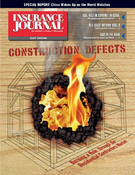New endorsements and court rulings make it more important than ever to be sure your construction-related clients understand how contractual liability coverage works.
A new endorsement effective July 2004 in many states amends the definition of an insured contract, limiting coverage to bodily injury and property damage “caused, in whole or in part, by you or by those acting on your behalf.” The change excludes coverage for the assumption of another party’s sole negligence. This could prove to be ambiguous in relationship to the indemnification agreement. Sole negligence is difficult to prove, but an insurer may argue that a claim arises out of the other party’s sole negligence and attempt to deny coverage.
If this endorsement has been filed in your state, begin discussing the ramifications with your general contractors and subcontractors now.
Although you would think that contractual liability provisions would be conspicuous and easy to understand, this belief too often falls into the category of myth. Coverage typically is provided as an exception to an exclusion and critically important factors to this coverage must be recognized.
Three common myths:
Myth 1. Contractual liability provisions will respond whether the indemnification is legally enforceable or not. States vary in interpreting these issues, but the net effect is to make the enforcement of indemnification provisions increasingly questionable.
For example, Texas courts have ruled the indemnification must be clear and unequivocal, expressly state the assumed negligence being indemnified, and be conspicuous. If it fails to meet each requirement, the court may rule that the indemnification provision is not legally enforceable.
The agreement states that the insurer will pay those sums that the insured becomes legally obligated to pay as damages because of bodily injury or damage to tangible property (subject to exclusions, conditions and limitations). If the indemnification provision is not legally enforceable, no coverage will be provided. Again, states differ in what they allow regarding indemnification. Be cautious.
Myth 2: The contractual liability provision will respond to all of the liability set forth in the indemnification requirement. Contractual liability simply applies the existing scope and amount of coverage to the indemnification requirement—it does not expand to cover all liabilities that may be included in that requirement. The exception states that coverage is provided for damages by reason of assumption in an “insured contract,” provided the bodily injury or damage to tangible property occurs after the contract’s execution. The coverage provided is actually quite limited in scope, applying only to damages arising out of bodily injury and damage to tangible property, not “injury,” or “personal injury,” or other any-and-all verbiage frequently used by attorneys. Business risks, such as breach of contract, are not covered.
Indemnification for exposures greater in scope or greater in amount than the limit of insurance is funded out of the assets of the indemnifying party (the indemnitor). Beware of hold harmless agreements—they are not harmless and are potentially bankrupting.
How often does work begin prior to execution of a contract? In such a case, no coverage is provided for incidents before the contract is signed.
Myth 3. Contractual liability coverage always includes all defense costs for the indemnified party, in addition to the limits of liability. The exception states that reasonable attorney fees and necessary litigation expenses incurred in defending another party are deemed to be damages, providing the defense of that party has also been assumed in an insured contract.
Many indemnification clauses require payment of attorney fees and fail to mention other litigation expenses. This permits an insurer to argue that no coverage is to be provided for those expenses. Many clauses also state that the one party must hold harmless and indemnify the other party, and may include attorney fees. There is a potentially wide gap between this and indemnification for all defense costs. If “defense” is not clearly required, the carrier can again argue that no such coverage is to be provided.
Too often contractors pay insufficient attention to endorsements and assume liabilities for which coverage is not available. Good brokers will help their clients avoid this trap.
Comiskey is chair, and Dennison a member, of the construction practice group of RiskProNet International. Comiskey is senior VP at Houston-based Brady, Chapman, Holland & Associates Inc. and president of RiskTech Inc. Dennison is director of construction, at AH&T Insurance in Leesburg, Va.
Was this article valuable?
Here are more articles you may enjoy.


 Product Liability Verdicts Are on the Rise but There Are Ways to Avoid Them
Product Liability Verdicts Are on the Rise but There Are Ways to Avoid Them  Acrisure CEO Greg Williams Makes $400M Commitment to Michigan State University
Acrisure CEO Greg Williams Makes $400M Commitment to Michigan State University  Florida, East Coast to See Big Insured Losses From More Cat 5 Storms, Researchers Say
Florida, East Coast to See Big Insured Losses From More Cat 5 Storms, Researchers Say  How ‘Super Roofs’ Reward Insurers, Cat Bond Investors and Homeowners
How ‘Super Roofs’ Reward Insurers, Cat Bond Investors and Homeowners 


